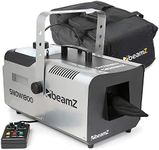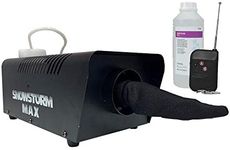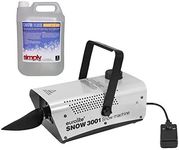Buying Guide for the Best Snow Machines
Choosing the right snow machine can greatly enhance your winter activities, whether you're looking to create a winter wonderland in your backyard or need reliable equipment for a ski resort. The key to finding the best snow machine for your needs is understanding the various specifications and how they align with your intended use. Here are some important specs to consider when selecting a snow machine.Snow OutputSnow output refers to the amount of snow a machine can produce over a certain period, usually measured in cubic feet per minute (CFM) or kilograms per hour. This spec is crucial because it determines how quickly you can cover an area with snow. For small home use, a lower output (e.g., 10-20 CFM) might be sufficient, while larger areas or commercial use may require a higher output (e.g., 50-100 CFM or more). Consider your space and how much snow you need when choosing the right output.
Snow QualitySnow quality refers to the texture and consistency of the snow produced. Some machines create finer, powdery snow, while others produce wetter, heavier snow. This is important depending on your intended use; for example, powdery snow is ideal for creating a realistic winter scene, while heavier snow might be better for building snow structures. Think about what you plan to do with the snow and choose a machine that produces the appropriate quality.
Operating TemperatureThe operating temperature is the range of temperatures within which the snow machine can effectively produce snow. This is important because not all machines can operate in all weather conditions. Some machines are designed to work in sub-freezing temperatures, while others can produce snow even in slightly warmer conditions. Consider the typical weather in your area and ensure the machine you choose can operate within those temperatures.
Water Source CompatibilityWater source compatibility refers to the type of water supply the snow machine can use, such as tap water, distilled water, or even a direct connection to a hose. This is important because it affects the convenience and feasibility of using the machine. For home use, a machine that connects to a standard garden hose might be ideal, while commercial operations might need a machine that can handle larger water sources. Think about your water supply options and choose accordingly.
Power SourceThe power source of a snow machine can be electric, gas-powered, or battery-operated. This spec is important because it affects where and how you can use the machine. Electric machines are typically quieter and more suitable for home use, while gas-powered machines might offer more power and mobility for larger areas. Battery-operated machines provide the most flexibility but may have limited run times. Consider where you will be using the machine and choose a power source that fits your needs.
PortabilityPortability refers to how easy it is to move and transport the snow machine. This is important if you need to use the machine in different locations or store it when not in use. Smaller, lighter machines are easier to move but may have lower output, while larger machines might be more powerful but harder to transport. Think about how often you will need to move the machine and choose one that balances portability with performance.
Noise LevelNoise level refers to how loud the snow machine is during operation, usually measured in decibels (dB). This is important if you plan to use the machine in residential areas or during events where noise could be a concern. Quieter machines are better for home use or public events, while noise might be less of an issue for commercial or remote applications. Consider the environment in which you will be using the machine and choose one with an appropriate noise level.













